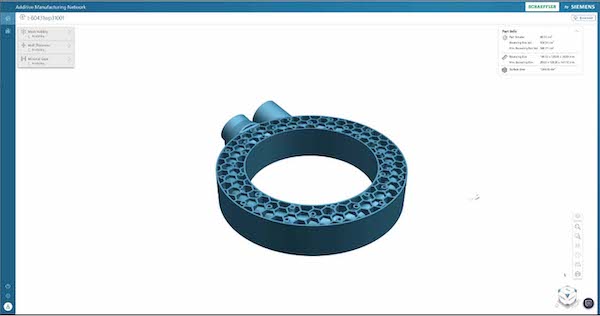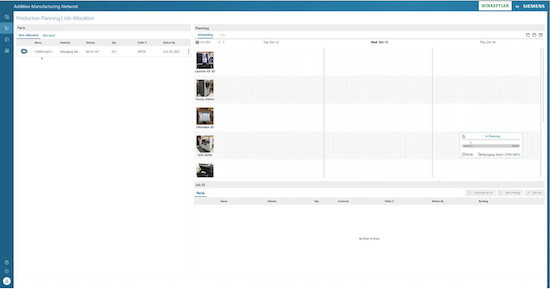Schaeffler Standardizes AM to Make It Production-Part Ready
Siemens AM Network to serve as the standard platform for streamlining entire AM order-to-delivery processes.

Schaeffler 3D part spray nozzle as it appears in AM Network 3D viewer. Image courtesy of Schaeffler Group.
Latest News
January 25, 2022
Like any good technology pioneer, Schaeffler has a past, present and future with additive manufacturing (AM) technology.
In the early 2000s, AM was solely used by Schaeffler for rapid prototyping—every printed part was affixed with a tag that said, “Look, but don’t touch.” A decade later, the global automotive supplier started making its first AM-produced functional prototypes, and by 2016, it was leveraging those prototypes with customers for road testing and actively deploying AM technologies to build production-grade tooling. Today, Schaeffler maintains 40 AM systems as part of a group dedicated to serving as an internal manufacturing service provider, cranking out around 3,000 prototype parts annually for internal customers across the globe.
Looking to its AM future, Schaeffler, like many automotive suppliers, sees real opportunity in leveraging new materials and metal 3D printing technologies to garner cost efficiencies and design advantages for serial parts production. Automotive manufacturers see potential for AM to improve the performance and functionality of newly designed parts through lightweighting and parts consolidation. They also see possibility for personalization and customization opportunities and the ability to shift to on-demand manufacturing as a means of replacing expensive physical inventory models with digital inventories, says Zvi Feuer, CEO of Siemens Industry Software, Israel.
“Automotive companies are looking to AM to accelerate innovation with their new product introductions, which means quicker iterations,” Feuer says. “They are also looking to better manage their supply chain—i.e., diversify global suppliers, allow for faster onboarding, and achieve better visibility and control on quality and delivery. As for their in-house operations, they are looking to better utilize their capital investments, while minimizing the need for additional labor.”
Challenges Abound
Despite the enthusiasm, workflow and standardization challenges are currently impeding AM’s use for serial parts production. At Schaeffler, AM print jobs are currently managed using Microsoft Excel, but as demand for AM parts has risen, so has the complexity of manually handling the surge of orders with a spreadsheet-driven process, according to Carsten Merklein, vice president, Advanced Manufacturing Technologies. It’s also become cumbersome and time-consuming to find pertinent information to inform AM print jobs among scattered data sources that include forms, emails and 3D models, he says.
Schaeffler’s disconnected AM workflows and reliance on a spreadsheet-based system undermine the broader benefits of 3D printing. The company finds it hard for the internal team to provide accurate pricing or quotes efficiently and it takes a lot of back and forth to communicate consistently on the status of specific orders let alone invite external partners into the process.
“Most of our inquiries and processing of orders in the additive manufacturing area are based off an Excel list and PowerPoint, which was okay when it was just a couple of hundred parts a year, but now we have thousands of inquiries and we can’t handle everything in the old-fashioned way,” Merklein explains. “All of this paperwork is done by people. We figured there is a lot of time to be saved if we standardized or automated.”
Introducing AM Network
To address these long-standing challenges, Schaeffler is now moving forward with a critical piece of the plan to get to production-level AM: implementation of Siemens Digital Industries Software’s AM Network, an online order-to-delivery collaboration platform. With AM Network, Schaeffler can execute on its strategy to streamline the AM production process through a single integrated system that spans the design, production and procurement of AM parts.
“Using a platform that standardizes information will speed up our process,” Merklein explains. “It will help contribute to the company’s agility goals.”

Schaeffler taps Siemens AM Network Production Planning Module as part of its initiative to streamline the entire AM order-to-delivery process. Image courtesy of Schaeffler Group.
AM Network, a cloud-native platform, will allow Schaeffler engineering and design users to maximize AM’s benefits more quickly, efficiently and at greater scale by digitizing and streamlining its end-to-end additive manufacturing processes. AM Network functions as an order-to-delivery collaboration platform that connects the demand and supply in additive manufacturing.
The platform is designed to make AM production knowledge accessible to design engineers and accelerates their competency in using AM. It helps part buyers easily locate certified suppliers for production needs, receive instant quotes and lead times, and monitor order progress.
Consider Schaeffler R&D designers and engineers working on AM parts as one instance where standardized processes can promote more effective use of AM, Merklein says. Instead of the AM Fab Shop having to constantly field inquiries from engineers about whether a particular part can be 3D printed, despite an available set of FAQs, AM Network makes a standard set of design guidelines easily accessible for up-front guidance. The software goes even further in automating printability checks, allowing engineers to get an instant response about the status of their model, he explains.
“They’ll know immediately if a wall thickness is too much or a radius too sharp and they can address the problem,” he says. “It allows them to come back with a more mature model for printing or set of precise questions we can answer. This helps with quality, the iterative design process and problem solving.”
Shop floor personnel manning the 3D printers will also benefit from the standardized workflows enabled by AM Network. Through one integrated platform, print operators can prepare the automotive parts for printing, handle design for AM (DfAM) printability, select materials and orchestrate post-processing and quality operations. Eventually, AM Network will be used to facilitate automated nesting of parts, which will do much to drive more efficient part production operations.
AM Network’s instant pricing, workflow automations and integration with existing enterprise landscape, including security controls like single sign-on log-ins, has helped Schaeffler shave 30 minutes per order from inquiry to delivery of parts. With the time savings, Merklein says teams are able to devote energy to other, higher value AM-related tasks rather than wasting time on digital paperwork.
While various companies offer platforms for managing AM workflows, Siemens AM Network fit the bill for Schaeffler for a number of reasons. The platform’s ability to integrate with enterprise systems like ERP was a huge draw, Merklein says, as is the fact that Siemens employs AM Network for its own operations—so it practices what it preaches. The platform also connects seamlessly with Schaeffler’s digital design and simulation tools, which include Siemen’s own NX platform.
Implementing a platform like AM Network to standardize and centralize AM workflows advances the promotion of a more widespread adoption of 3D printing, especially for production-grade use cases.
“It’s all about empowering people to understand AM and to do that, you need a certain set of guidelines,” Merklein explains. “We’re not at a level where we have the same amount of knowledge as we do for conventional manufacturing processes so users of AM have to do a lot of standardization themselves. AM Network helps with that standardizing process.”
Beth Stackpole is a contributing editor to DE. You can reach her at [email protected].
More Siemens Digital Industries Software Coverage
Subscribe to our FREE magazine, FREE email newsletters or both!
Latest News
About the Author
Beth Stackpole is a contributing editor to Digital Engineering. Send e-mail about this article to [email protected].
Follow DE





